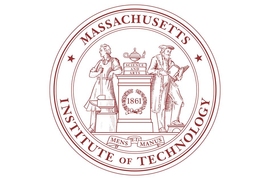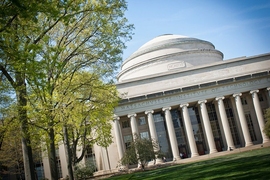MIT’s expansive effort to envision, and position itself for, a post-Covid world — Task Force 2021 and Beyond (MIT Beyond) — is now under way.
With a letter today to the MIT community, co-chairs Rick Danheiser and Sanjay Sarma formally launched MIT Beyond, a collaborative, cross-Institute team composed of some 150 faculty, staff, and students.
“Covid-19 has forced changes in how we all live, work, and learn — and there may be no full return to our old ‘normal,’” wrote Danheiser, chair of the faculty and Arthur C. Cope Professor of Chemistry, and Sarma, vice president for open learning and Fred Fort Flowers and Daniel Fort Flowers Professor of Mechanical Engineering. “This task force will seek to use the lessons of this extraordinary time to explore how we might invent a robust new future: What has this experience taught about what we value most in the MIT experience? What worked better than expected? And where might we now have the opportunity to make beneficial changes in how we operate at MIT?”
Danheiser and Sarma invited members of the MIT community to attend an online forum to be held on Thursday, July 23, and to submit initial suggestions and thoughts via a dedicated Idea Bank.
MIT Beyond was charged by President L. Rafael Reif two months ago to “explore how MIT might invent a thriving new future” — starting in 2021, and possibly far into the future. In a May 4 letter to the MIT community, he likened the current climate to the uncertainty of World War II, a period of global disruption when the Institute underwent a spectacular transformation.
“As MIT helped the United States respond to the immediate threats of war, it invented a new future for itself,” President Reif wrote. “By framing a productive new relationship between the federal government and research universities, MIT helped the nation come to see the advance of fundamental science as a core US strength — and established a lead role for itself in that work. World War II also turned MIT from a technical college with a handful of graduate students to a great research university. … In other words, the painful demands of that terrible war ultimately delivered much of what we now love about MIT.”
The global spread of Covid-19 over just the past six months has quickly created a “new normal”: Beyond the sharp economic downturn it has unleashed, the pandemic appears set to reorient global trade and the retail, travel and hospitality, and real estate sectors, among others. It has rapidly accelerated the growth of telemedicine, appears poised to reshape international relations and domestic politics, and has forced a reconsideration of sustainability. Finally, the pandemic has prompted a sharp shift in work and education, with billions of people worldwide now working and learning from home.
At MIT, Covid-19 holds the potential for strong impacts on the endowment, government and industry support, and private philanthropy. The pandemic could have ongoing repercussions on the financial well-being of MIT’s students and their families, on the job market for MIT graduates, and on research directions and funding. Finally, the current state of affairs could have long-term effects on how MIT employees approach their work, and could launch higher education into a next phase of digital transformation, with profound impacts on both education and student life on residential campuses like MIT’s.
Key questions for the members of MIT Beyond will include:
- What have we learned about what we treasure most in the MIT experience? How do we improve that experience?
- While dealing an impact to our budgets, the virus has simultaneously created much more financial need for students; can we develop a farsighted, long-term solution?
- Can we use this radical retreat from campus as a moment to rethink how we use the physical spaces we have?
- And broadly, can we imagine new, more efficient, effective, inclusive, and flexible ways to live up to the challenge of our mission?
The task force’s charge reads, in part: “Task Force 2021 will distill and apply the knowledge we have gained together to help us imagine an MIT that is better, safer, more flexible, more effective, more efficient, more sustainable, more inclusive, more equitable, more affordable, and more financially resilient in the long term, while sustaining the Institute’s distinctive values and culture and its dynamic approach to education, research, and innovation. In short — by drawing on expertise and experience from across the community — Task Force 2021 is charged with developing the blueprints for building a better MIT.”
MIT Beyond’s members are organized into four large workstreams, comprising 10 working groups, as well as two resource teams:
- The Academic Workstream will examine academic opportunities and implications as MIT plans for the “new normal,” with potential changes in its economic, technological, and cultural realities. Its focus will primarily include education and research activities that impact undergraduate students, graduate students, faculty, postdocs, research staff, and student life staff. Co-chairs: Anantha Chandrakasan, dean of the School of Engineering and Vannevar Bush Professor of Electrical Engineering and Computer Science; Melissa Nobles, Kenan Sahin Dean of the School of Humanities, Arts, and Social Sciences and professor of political science
- The Administrative Workstream will examine administrative opportunities and implications as MIT plans for the “new normal.” Administrative functions include information technology infrastructure; non-classroom, non-residential space, including research lab space, office space, commercial space, and other real estate; and administrative systems, processes, and policies in finance, procurement, facilities, security, planning, human resources, and other areas. Co-chairs: Joe Higgins, vice president for campus services and stewardship; Krystyn Van Vliet, associate provost and Michael and Sonja Koerner Professor of Materials Science and Engineering
- The Finance and Data Workstream’s primary role is to review certain key financial and funding models for ongoing Institute activities. This workstream will also support the other working groups by providing financial perspectives, data and research support, and support for financial modeling and financial feasibility analyses. Co-chairs: Glenn Ellison, Gregory K. Palm Professor of Economics; Danielle Khoury, controller
- The Community and Culture Workstream will focus on culture, diversity, equity, inclusion, community, and values at MIT, and particularly on how these themes will be included strategically and implemented tactically in the context of the work of MIT Beyond. Co-chairs: John Dozier, Institute Community and Equity Officer; Tim Jamison, associate provost and Robert R. Taylor Professor of Chemistry
MIT Beyond expects to deliver a preliminary report to President Reif in the fall and a final report in early 2021.








